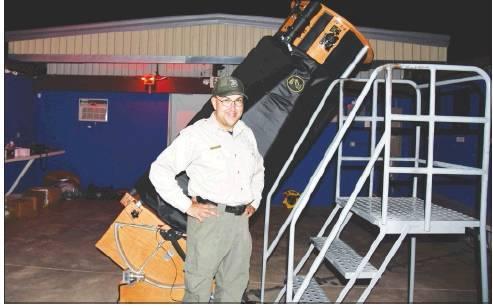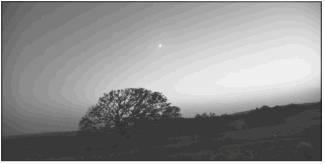The starry sky comes to life at Reimers Ranch
REIMERS OBSERVATORY
Now you can take a tour of the solar system and galaxy without leaving the Dripping Springs area.
Reimers Observatory, at Reimers Ranch Park, is entering into its third year of hosting nighttime programs for people interested in peeking beyond the confines of the Earth.
The program hosted on Sunday, July 15, by Reimer’s Ranch Park Astronomer Michael Brewster was typical of what stargazers can expect. “Tonight, we’ll begin by looking at our closest neighbors, the Moon and the Planet Venus side by side with high powered binoculars, after that we will move over to the two telescopes and see the planets Jupiter and Saturn, along with some their planetary moons,” Brewster said by way of introducing the evening’s agenda.
Using the two telescopes on site, visitors were wowed as they were able to clearly see Jupiter’s cloud belts and one of Jupiter’s moons Europa. For the planet Saturn, visitors were able to clearly see details in Saturn’s famous rings, including a black racing stripe which was explained. “If you notice, there’s a black racing stripe in the rings of Saturn. That black racing stripe is actually a gap in the debris that forms the rings. Whenever material from one of the rings begins to enter that gap, the gravity of one of two moons orbiting near the edge of the rings, Prometheus and Pandora, pull the material back into the ring. That’s why they’re called shepherding moons. The gap in the rings is useful for NASA, as they can fly probes through the gap without the worry of wrecking a space probe by hitting the stuff in the rings,” Brewster said. “The gap is probably near the length of the Earth, maybe a little smaller.”
The park program attracted visitors from various locations, including Cedar Park. “It’s about an hour-plus-drive for me,” Marc Wiz, a first-time park observatory said. “But I heard about the show, and I wanted to check it out. This is the first time I’ve clearly seen Saturn’s rings. It’s much better than the view you can get from a store-bought telescope. I still have to drive back tonight, then get up for work at 5 a.m. tomorrow morning, but it was worth it.”
Throughout the program, guests were also notified when space satellites and space junk would fly overhead. The satellites were visible to the naked eye due to a lack of light pollution at Reimer’s Ranch.
The telescope viewing also left the confines of the solar system as Brewster brought into focus dying stars and clusters where stars were being born. One of the stars of the evening was the Ring Nebula, also known as M57, a dying star in the constellation Lyra which has expelled much of itself out into space. “M57 was much like our own sun many years ago. It’s about 2,000 light years away. That means the light you’re seeing is from 2,000 years ago,” Brewster said.
As he aimed the telescopes at regions towards the center of our galaxy, Brewster also explained that there’s a current project by astronomers to take the first photo of the black hole which is supposed to be at the center of our Milky Way Galaxy. “To get the photo, they need a telescope the size of the Earth. So, what they’re doing is tying in observatories from all over the world to create that one image. If they’re successful, it will be the first photograph of a black hole. Previously, we’ve only seen matter at the edge of the event horizon of a black hole,” Brewster said.
Park Supervisor Michael Brewster who led the program holds an Astronomy Degree from the University of Texas.
For a complete schedule of Reimers Observatory, please visit: https://parks.traviscountytx.gov/find-a-park/reimersranch/observatory. Reservations are required. To see objects through the telescopes, guests may have to climb a small stepladder.




